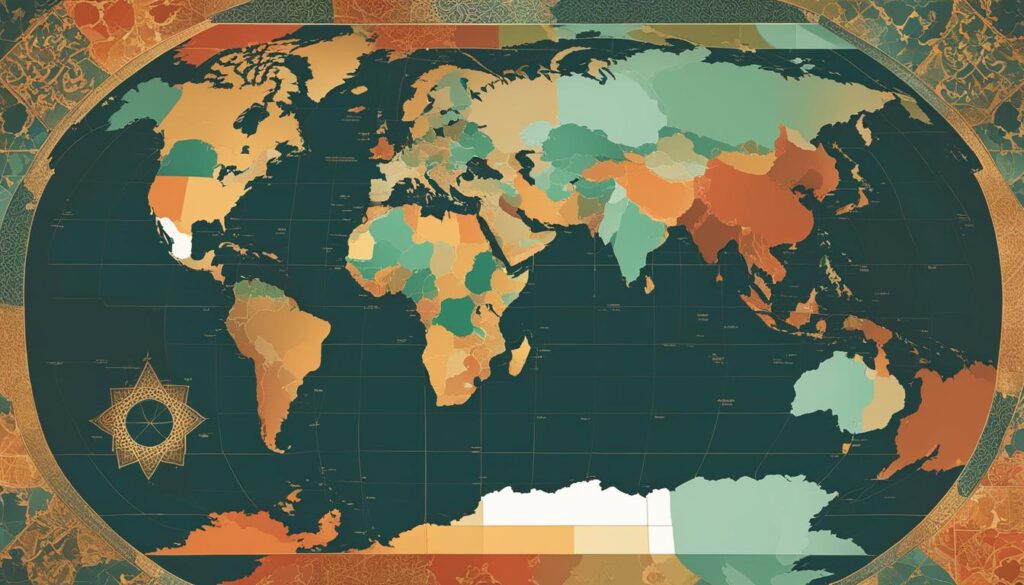The differences between Islamic Sunnah and Shia Hadith lie in questions of religious authority and leadership after the death of the Prophet Muhammad. Sunni Muslims, who follow the example set by the Prophet, believe that the successor should be someone who upholds his customs. Shi’a Muslims, on the other hand, believe that the successor should be a member of the Prophet’s bloodline, starting with his cousin and son-in-law, Hazrat Ali. Both Sunni and Shia Muslims draw on the Qur’an and Hadith, and they both adhere to the Five Pillars of Islam.
Key Takeaways:
- The difference between Islamic Sunnah and Shia Hadith lies in questions of religious authority and leadership.
- Sunni Muslims believe the successor should uphold the customs of the Prophet, while Shi’a Muslims believe the successor should be from the Prophet’s bloodline.
- Both Sunni and Shia Muslims draw on the Qur’an and Hadith and adhere to the Five Pillars of Islam.
- Understanding these differences is crucial for gaining insight into the geopolitical conflicts and community tensions among Sunni and Shia Muslims.
- Tensions are often fueled by external factors, such as power imbalances and geopolitical conflicts.
Similarities Between Sunni and Shia Muslims
Despite their differences, Sunni and Shia Muslims share common beliefs and practices. Both sects of Islam draw on the teachings of the Qur’an, which is considered the holy book of Islam. They also both derive guidance from the Hadith, which are collections of sayings and actions of the Prophet Muhammad.
While Sunni and Shia Muslims may favor different collections of Hadith, they both acknowledge the importance of these teachings in understanding and interpreting Islamic teachings. The Hadith serve as a valuable source of guidance on matters of faith, morality, and daily life.
In addition to their shared reliance on the Qur’an and Hadith, Sunni and Shia Muslims adhere to the Five Pillars of Islam. These pillars include the declaration of faith, prayer, charitable giving, fasting during Ramadan, and pilgrimage to Mecca. Both sects consider these practices essential to their faith and strive to uphold them in their daily lives.
Table: Comparison of Sunni and Shia Muslims
| Beliefs | Sunni | Shia |
|---|---|---|
| Leadership | Believe that the successor to the Prophet Muhammad should be someone who upholds his customs. | Believe that the successor should be a member of the Prophet’s bloodline, starting with Hazrat Ali. |
| Religious Hierarchy | Has a less elaborate religious hierarchy. | Gives higher status to the Imams, often venerating them as saints. |
| Schools of Law | Has their own schools of law. | Also has their own schools of law, with slight variations in their application. |
It is important to recognize these similarities between Sunni and Shia Muslims to foster mutual understanding and respect. While their differences may lead to tensions and conflicts, it is essential to focus on the shared values and teachings that both sects hold dear.
Differences in Religious Authority
One of the key distinctions between Sunni and Shia Islam revolves around the question of religious authority and leadership within the faith. Sunni Muslims believe that the successor to the Prophet Muhammad should be someone who follows his customs, while Shia Muslims believe that the successor should be someone from the Prophet’s bloodline, starting with Hazrat Ali, his cousin and son-in-law. This difference in belief has significant implications for the religious hierarchy and decision-making processes within each sect.
Within Sunni Islam, religious authority is typically decentralized, and there is no single leader who holds ultimate authority over the entire community. Instead, Sunni Muslims follow the guidance of learned scholars and imams who interpret Islamic teachings and provide guidance on religious matters. The interpretation and application of religious doctrine are often left to individual Muslims or local communities, resulting in a more diverse range of practices and beliefs.
In contrast, Shia Islam has a more centralized religious hierarchy, with a supreme religious leader known as the Grand Ayatollah or Marja’ al-Taqlid. The Grand Ayatollah is considered the highest religious authority within Shia Islam and is responsible for interpreting Islamic teachings and issuing religious decrees. This centralized authority provides a more unified structure and a clear line of leadership within the Shia community, with the Grand Ayatollah playing a significant role in shaping religious practices.
Table: Sunni and Shia Differences in Religious Authority and Leadership
| Aspect | Sunni Islam | Shia Islam |
|---|---|---|
| Religious Authority | Decentralized, with guidance from scholars and imams | Centralized, with a supreme religious leader |
| Leadership | No single leader, individual or local community-based | Grand Ayatollah or Marja’ al-Taqlid |
| Succession | Based on adherence to the customs of the Prophet Muhammad | Based on bloodline, starting with Hazrat Ali |
Historical Context and Geopolitical Conflicts
Tensions between Sunni and Shia communities in the Middle East have deep historical roots and have been further exacerbated by geopolitical conflicts in the region. One significant factor contributing to these tensions is the revolution in Iran in 1979, which led to the establishment of a Shi’a theocracy and increased support for Shia communities in countries like Iraq, Saudi Arabia, and Bahrain. This shift in power dynamics created a sense of threat and competition between Sunni and Shia Muslims, fueling long-standing tensions.
Another source of conflict is the violence committed by Sunni-dominated governments against their Shia populations. Particularly in countries like Iraq and Syria, where Sunni rulers have been accused of discriminative policies and suppression of Shia communities, tensions have reached critical levels. These conflicts and power struggles have led to a cycle of violence, creating a deep divide between the two sects.
Furthermore, the rise of extremist groups such as ISIS has intensified Sunni-Shia tensions. This radical ideology has targeted Shi’a Muslims and their religious sites, exacerbating existing conflicts. The Middle East has become a battleground for sectarian violence, and these tensions have spilled over into diasporic communities, creating additional challenges and social unrest in other parts of the world.
| Country | Sunni Population | Shia Population |
|---|---|---|
| Saudi Arabia | 75-90% | 10-15% |
| Iran | 10-15% | 85-90% |
| Iraq | 65-75% | 25-35% |
| Lebanon | 30-40% | 30-40% |
Key Points:
- The revolution in Iran in 1979 increased support for Shia communities across the Middle East, leading to heightened tensions with Sunni Muslims.
- Sunni-dominated governments, particularly in Iraq and Syria, have been accused of discriminating against and suppressing their Shia populations, further fueling sectarian divisions.
- The rise of extremist groups like ISIS has intensified violence against Shi’a Muslims and their religious sites, exacerbating existing conflicts.
- Sunni and Shia tensions in the Middle East have also impacted diasporic communities, creating additional challenges and social unrest globally.
Global Distribution of Sunni and Shia Muslims
Sunni and Shia Islam are two major branches of the Islamic faith, and together they constitute the majority of the world’s Muslim population. However, there are significant differences in their global distribution.
Sunni Muslims make up the majority of the global Muslim population, with estimates ranging from 85 to 90 percent. They can be found across the Muslim world, spanning regions from West Africa to Southeast Asia. Sunni Islam is the dominant form of Islam in countries such as Egypt, Saudi Arabia, Turkey, and Indonesia.
On the other hand, Shia Muslims constitute around 10 to 15 percent of all Muslims, with a global population of less than 200 million. They are primarily concentrated in specific regions such as Iran, Iraq, Syria, Lebanon, and Yemen. Iran, in particular, has the largest Shia population in the world.
| Region | Percentage of Sunni Muslims | Percentage of Shia Muslims |
|---|---|---|
| Middle East and North Africa | 90% | 10% |
| South Asia | 95% | 5% |
| Southeast Asia | 90% | 10% |
| Sub-Saharan Africa | 75% | 25% |
| Europe | 75% | 25% |
| Americas | 85% | 15% |
It is important to note that the distribution of Sunni and Shia Muslims is not uniform within each region. For example, while Sunni Muslims are the majority in South Asia, there are significant Shia populations in countries like Iran, India, and Pakistan. Similarly, in the Middle East and North Africa, Shia Muslims are concentrated in countries like Iran, Iraq, Bahrain, and Lebanon, while Sunni Muslims are the majority in other countries of the region.
The global distribution of Sunni and Shia Muslims is a reflection of historical, cultural, and geopolitical factors. Understanding these demographics is crucial for comprehending regional dynamics, geopolitical conflicts, and community tensions among Sunni and Shia Muslims.

Interpretations and Practices
In terms of interpretations and practices, Sunni and Shia Muslims have some key differences. Firstly, Sunni Islam has a less elaborate religious hierarchy compared to Shia Islam. While Sunni Muslims may have scholars, imams, and local leaders, there is no specific centralized religious authority or clergy. On the other hand, Shia Islam has a more structured hierarchy that revolves around the concept of Imams, who are considered to have special spiritual and political authority.
Additionally, the veneration of religious figures differs between Sunni and Shia Islam. While Sunni Islam does not venerate any specific individuals as saints, Shia Islam places a higher status on Imams, often venerating them as saints and seeking their intercession. This difference in the veneration of religious figures has an impact on the religious rituals, celebrations, and practices of the two sects.
Furthermore, both Sunni and Shia Islam have their own schools of Islamic law, known as Madhhabs. These schools of thought provide guidance on how to interpret and apply Islamic teachings in various aspects of life. While there are similarities between the schools of thought in terms of fundamental principles, there are slight variations in their interpretations and practices. This diversity within each sect adds to the richness and complexity of Islamic jurisprudence.
Examples of Differences:
Here are some specific examples of differences in interpretations and practices between Sunni and Shia Islam:
- In terms of prayer, Sunnis generally follow the Hanafi, Maliki, Shafi’i, or Hanbali school of thought, while Shia Muslims follow the Jafari school of thought. This leads to differences in the performance and timings of prayers.
- During the month of Muharram, Shia Muslims commemorate the martyrdom of Imam Hussein, the grandson of Prophet Muhammad, through processions and rituals. This practice is not observed by Sunni Muslims.
- The practice of temporary marriage, known as Mut’ah, is accepted by some Shia Muslims but not recognized by Sunni Muslims.
| Interpretations and Practices | Sunni Islam | Shia Islam |
|---|---|---|
| Religious Hierarchy | No specific centralized religious authority or clergy. | Structured hierarchy with special authority given to the Imams. |
| Veneration of Religious Figures | Does not venerate specific individuals as saints. | Venerates Imams as saints and seeks their intercession. |
| Schools of Islamic Law | Follows the Hanafi, Maliki, Shafi’i, or Hanbali school of thought. | Follows the Jafari school of thought. |
It is important to note that these differences should be understood within the broader context of the shared beliefs and practices of Sunni and Shia Muslims. Both sects consider themselves to be Muslims following the teachings of the Quran and the Prophet Muhammad. While there may be tensions and disagreements at times, it is essential to approach these differences with respect, understanding, and an open mind.
Current Tensions and Impact
The ongoing tensions between Sunni and Shia communities have had far-reaching implications, both regionally and globally. These conflicts have been marked by violence, sectarianism, and geopolitical complexities. Understanding the dynamics of Sunni-Shia relations is crucial for comprehending the complexities of these conflicts and their impact on various communities.
Tensions and Conflicts
The Sunni-Shia conflicts have been fueled by a combination of historical, political, and religious factors. Geopolitical conflicts and power struggles have played a significant role in exacerbating these tensions. Geographically, these conflicts are most pronounced in the Middle East, where regional players have vested interests in supporting one sect over the other. This has resulted in violence and instability in countries like Iraq, Syria, Yemen, and Bahrain.
Global Implications
The impact of Sunni-Shia tensions extends beyond the Middle East. Diasporic communities in the West have also been affected, as these conflicts often find a way to permeate into different societies. The rise of extremist groups, such as ISIS, has further intensified these tensions and increased the threat of terrorism globally. The repercussions of these conflicts can be seen in the form of radicalization, discrimination, and even acts of violence against individuals from both sects in various parts of the world.
Importance of Understanding
It is essential to approach the topic of Sunni-Shia relations and conflicts with nuance and understanding. External factors, such as geopolitical interests, have played a significant role in fueling these tensions. Recognizing these complexities is crucial for fostering dialogue, promoting peaceful coexistence, and working towards lasting solutions. By gaining a deeper understanding of the current tensions and their impact, we can contribute to building bridges, fostering religious tolerance, and promoting stability in the affected regions and beyond.
| Current Tensions and Impact |
|---|
| Sunni-Shia conflicts |
| Sunni and Shia relations |
Conclusion
The difference between Islamic Sunnah and Shia Hadith lies in questions of religious authority and leadership. Sunni Muslims believe that the successor to the Prophet Muhammad should be someone who upholds his customs, while Shi’a Muslims believe that the successor should be a member of the Prophet’s bloodline. Despite these differences, Sunni and Shia Muslims share common beliefs and practices, drawing on the Qur’an and Hadith and adhering to the Five Pillars of Islam.
Tensions between Sunni and Shia communities have historical roots and have been exacerbated by geopolitical conflicts. The rise of a Shi’a theocracy in Iran and violence committed by Sunni-dominated governments have fueled these tensions, leading to violence and sectarianism. These tensions have not only impacted the Middle East but also spilled over into diasporic communities in the West.
It is important to approach these differences with religious literacy and recognize that tensions between Sunni and Shia communities are often influenced by external factors. Understanding the difference between Islamic Sunnah and Shia Hadith provides insight into the conflicts and tensions among Sunni and Shia Muslims, allowing for greater understanding and dialogue.
FAQ
What is the difference between Islamic Sunnah and Shia Hadith?
The difference lies in questions of religious authority and leadership after the death of the Prophet Muhammad. Sunni Muslims believe the successor should uphold the Prophet’s customs, while Shi’a Muslims believe the successor should be from the Prophet’s bloodline.
What are the similarities between Sunni and Shia Muslims?
Both Sunni and Shia Muslims accept the centrality of the Qur’an and draw on the Hadith. They also adhere to the Five Pillars of Islam, which include the declaration of faith, prayer, charitable giving, fasting during Ramadan, and pilgrimage to Mecca.
What are the differences in religious authority between Sunni and Shia Islam?
Sunnis believe the successor to the Prophet Muhammad should follow his customs, while Shi’a believe the successor should be from the Prophet’s bloodline. This difference in belief has led to tensions between the two communities.
What is the historical context and significance of Sunni and Shia tensions?
Tensions between Sunni and Shia communities have historical roots and have been exacerbated by geopolitical conflicts. The rise of a Shi’a theocracy in Iran and violence committed by Sunni-dominated governments have intensified these tensions.
Where are Sunni and Shia Muslims primarily located?
Sunni Muslims can be found across the Muslim world, while Shia Muslims are primarily concentrated in Iran, Iraq, Syria, Lebanon, and Yemen.
How do interpretations and practices differ between Sunni and Shia Islam?
Sunni Islam has a less elaborate religious hierarchy compared to Shia Islam. Additionally, Shia Islam gives higher status to the Imams, often venerating them as saints, while Sunni Islam does not. Both sects have their own schools of law with slight variations in their application.
What is the current impact of tensions between Sunni and Shia communities?
Geopolitical conflicts and power imbalances have fueled violence and sectarianism between Sunni and Shia communities. The rise of extremist groups like ISIS has further intensified these tensions. The impacts are felt both regionally and globally.
What is the conclusion regarding the difference between Islamic Sunnah and Shia Hadith?
Understanding the difference in religious authority and leadership between Sunni and Shia Muslims is crucial for comprehending conflicts and tensions. While there are differences, both sects share common beliefs and practices, and it is important to approach these differences with religious literacy and recognize external factors that fuel tensions between communities.
 Skip to main content
Skip to main content


